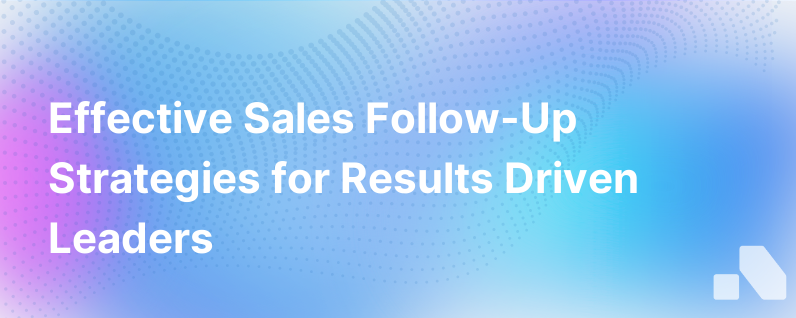
Effective sales follow-up strategies are the cornerstone of successful deal closures. In the contemporary sales arena, where prospects are bombarded with countless pitches and information, standing out and remaining top of mind requires well-executed follow-up techniques. The follow-up is where the true art of sales shines, demonstrating tenacity, personalization, and strategic timing.
Understanding the Importance of Sales Follow Ups
Before we delve into strategies, let's underscore why follow-ups are pivotal. They are not mere reminders of your product or service but are opportunities to:
- Reinforce the value proposition.
- Build a stronger relationship with the prospect.
- Address any questions or concerns that might arise post-pitches or meetings.
Many sales are lost not because the prospect wasn’t interested, but because they were not followed up with adequately. In fact, studies suggest that it can take an average of five follow-ups before a customer says yes, yet many salespeople give up after just one or two.
A follow-up strategy can be the bridge between initial interest and a closed deal. Here are the core components and thoughtful strategies to consider:
Crafting Effective Follow-Up Messages
Here's the crux: your follow-up message should add value and remind the prospect why your solution is the best fit for their needs. A good follow-up message might touch on:
- Key takeaways from your last conversation.
- New insights or resources related to their pain points or goals.
- A case study or testimonial that speaks to similar scenarios.
- Tailored solutions or offers.
Timing your message is also crucial. A prompt follow-up, ideally within 24 hours, keeps the conversation fresh and your product or service top of mind.
Tailoring the Approach to Different Prospects
Every prospect is unique, and a successful follow-up strategy addresses this. Segmentation is your ally in categorizing prospects based on their interest level, position in the sales funnel, and personal preferences for communication.
- Highly Interested Prospects: These individuals need nurtured follow-ups focusing on deepening the relationship, clarifying complex features, or arranging personalized demos.
- Medium Interest Prospects: Here, your follow-ups might aim to ignite enthusiasm by presenting compelling use cases or customer success stories.
- Low-Interest Prospects: For these leads, reiterating the business case and proposing an exploratory conversation or trial might reawaken their interest.
Tailoring also applies to the method of follow-up. Some prospects may prefer email, others phone calls, while some may respond better to LinkedIn messages or even text.
Frequency and Timing of Follow-Ups
Persistent follow-up is key, but bordering on annoyance can damage potential relationships. Establish a cadence that is assertive yet respectful of the prospect’s time and decision-making process. A schedule might look like:
- Initial Follow-Up: Send within 24 hours of your last interaction.
- Second Follow-Up: 2-3 days later, in case there has been no response.
- Subsequent Follow-Ups: Space these out by 3-7 days, gradually lengthening the interval between touchpoints.
Be prepared to be flexible, however. If a lead indicates they have a critical initiative or decision timeline, adjust your follow-up schedule accordingly.
Strategic Persistence – Knowing When to Pause
Persistence shines, but it must be strategic. Respect clear signals that a prospect is currently not in a position to move forward. In such cases, adopt a nurturing sequence where you provide continual value without pressuring for a sale. Keep these leads warm with industry insights or company updates, showing that you are there when they are ready to reengage.
Leveraging CRM and Automation Tools
It’s easy for follow-up tasks to slip through the cracks in a busy sales environment. Using a CRM to set reminders and monitor follow-up activities ensures that opportunities are not missed due to oversight.
Furthermore, harnessing automation tools allows for timely and consistent communication. Personalized automated emails can nurture leads and save valuable time for sales reps who then can concentrate on higher-value interactions.
Practice Active Listening
In any follow-up, it should be evident that you are actively listening to the prospect’s needs and feedback. Mentioning specific pain points or objectives discussed in previous encounters shows attentiveness and a genuine understanding of their business challenges.
Wrap Up with a Clear Call to Action
Every follow-up should conclude with a clear call to action. Whether that's arranging the next meeting, inviting them to a webinar, or asking for their thoughts on a resource you sent, make it clear what the desired next step is.
Utilizing Aomni for Strategized Follow-Ups
Incorporating platforms like Aomni can be a significant advantage in formulating effective follow-up strategies. Aomni's AI-driven insights ensure that follow-ups are not only well-timed but filled with substance that is tailored to each prospect's distinct context and needs.
In Conclusion
Skillful follow-up strategies are instrumental in curating strong connections, engaging potential customers effectively, and establishing your brand as attentive and proactive. In today's fast-moving market landscape, where attention spans are short, and competition is high, an optimized follow-up strategy could be the differentiator between closing and losing a deal. Harnessing these strategies and supporting tools like Aomni will position your sales team to capitalize on every lead and maximize each engagement.